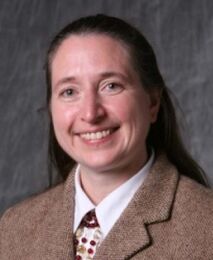Biography:Heidi Jo Newberg
Heidi Jo Newberg | |
|---|---|
 Photograph by Kris Qua, Rensselaer Polytechnic Institute | |
| Born | |
| Nationality | United States |
| Alma mater | University of California, Berkeley (Ph.D. 1992) Rensselaer Polytechnic Institute (B.Sc. 1987) |
| Known for | Structure of the Milky Way galaxy |
| Awards | Gruber Prize in Cosmology (2007, shared) Breakthrough Prize in Fundamental Physics (2015, shared) |
| Scientific career | |
| Fields | Astrophysics |
| Institutions | Fermilab, Rensselaer Polytechnic Institute |
| Doctoral advisor | Richard A. Muller |
Heidi Jo Newberg (née Marvin) is an United States astrophysicist known for her work in understanding the structure of our Milky Way galaxy. Among her team's findings are that the Milky Way is cannibalizing stars from smaller galaxies[1][2][3] and that the Milky Way is larger and has more ripples than was previously understood.[4] She is a founding participant in the Sloan Digital Sky Survey (SDSS) and the Sloan Extension for Galactic Understanding and Exploration (SEGUE),[5] and is a leader of the astrophysical MilkyWay@home distributed computing project team. She is a Professor of Physics, Applied Physics, and Astronomy at Rensselaer Polytechnic Institute (RPI) in Troy, New York, USA and a Fellow of the American Physical Society.
Career
Newberg received her bachelor's degree in Physics from the Rensselaer Polytechnic Institute in 1987. She received her Ph.D. in Physics from the University of California, Berkeley in 1992, working on the Berkeley Automated Supernova Search, which measured the supernova rates as a function of supernova type in Virgo-distance galaxies; and the Supernova Cosmology Project, which measured the cosmological parameters Omega and Lambda using the light curves of distant supernovae, and provided strong evidence that the expansion of our universe is accelerating.[6] In 2007, she shared the Gruber Prize in Cosmology along with the other members of the Supernova Cosmology Project[7] and in 2011 the group's lead won the Nobel Prize in Physics.[8][9] Newberg shared the 2015 Breakthrough Prize in Fundamental Physics along with other members of the Supernova Cosmology Project.[10]
At Fermilab, she worked on the Sloan Digital Sky Survey starting in 1992, and the Sloan Extension for Galactic Understanding and Exploration. She joined the faculty of Rensselaer Polytechnic Institute in 1999. Newberg is also the president of the board of trustees of the Dudley Observatory and director of the Hirsch Observatory. In 2012, she was elected a Fellow of the American Physical Society "for her contributions to our understanding of the structure of the Milky Way and the universe and for the development software and hardware infrastructure for measuring and extracting meaningful information from large astronomical survey data sets."
She has published papers in diverse areas of galactic and extragalactic astronomy, including: supernova phenomenology, measuring cosmological parameters from supernovae, galaxy photometry, color selection of QSOs, properties of stars, and the structure of our galaxy.
Personal life
Newberg was born in Washington, D.C. She is married to Lee Newberg and has four children.
References
- ↑ Glanz, James (April 11, 2000). "Halo Reveals Remains of Milky Way's Galactic Snacks". The New York Times. https://www.nytimes.com/2000/04/11/science/halo-reveals-remains-of-milky-way-s-galactic-snacks.html. Retrieved November 15, 2011.
- ↑ Newberg, Heidi Jo; Yanny, Brian; Rockosi, Connie; Grebel, Eva K.; Rix, Hans-Walter; Brinkmann, Jon; Csabai, Istvan; Hennessy, Greg et al. (April 10, 2002). "The Ghost of Sagittarius and Lumps in the Halo of the Milky Way". Astrophysical Journal 569 (1): 245–274. doi:10.1086/338983. Bibcode: 2002ApJ...569..245N.
- ↑ Wilford, John Noble (January 14, 2003). "In Galaxies Near and Far, New Views of Universe Emerge". The New York Times. https://www.nytimes.com/2003/01/14/science/in-galaxies-near-and-far-new-views-of-universe-emerge.html. Retrieved November 15, 2011.
- ↑ Carlisle, Camille M. (March 16, 2015). "Ripples in the Milky Way". Sky & Telescope. http://www.skyandtelescope.com/astronomy-news/ripples-in-the-milky-way-0316201523/.
- ↑ "The Sloan Digital Sky Survey turns its eye on the galaxy" (Press release). Sloan Digital Sky Survey. January 11, 2006. Retrieved November 15, 2011.
- ↑ Wilford, John Noble (March 3, 1998). "Wary Astronomers Ponder An Accelerating Universe". The New York Times. https://query.nytimes.com/gst/fullpage.html?res=9C0DE6DC1431F930A35750C0A96E958260&sec=&spon=&pagewanted=all. Retrieved November 15, 2011.
- ↑ "Newberg Shares Gruber Prize for Discovering Rapid Expansion of Universe" (Press release). Rensselaer Polytechnic Institute. July 30, 2007. Retrieved November 15, 2011.
- ↑ Overbye, Dennis (October 5, 2011). "3 Win Nobel for Work on Accelerating Universe". The New York Times: p. A11. https://www.nytimes.com/2011/10/05/science/space/05nobel.html. Retrieved November 15, 2011.
- ↑ The Editors (October 8, 2012). "Expand the Nobel Prize to Award Teams, Not Just Individuals". Scientific American. http://www.scientificamerican.com/article.cfm?id=expand-nobel-prize-award-teams-not-just-individuals. Retrieved October 24, 2012.
- ↑ Martialay, Mary L. (November 20, 2014). "Rensselaer Professor Shares 2015 Breakthrough Prize in Fundamental Physics: Heidi Newberg Recognized as Part of Award to Supernova Cosmology Project" (Press release). Rensselaer Polytechnic Institute. Retrieved 2015-03-20.
External links
- Heidi Jo Newberg's webpage at the Rensselaer Polytechnic Institute
- List of scholarly publications as provided by the SAO/NASA Astrophysics Data System (ADS) abstract server.
- Chapter contributor to Motherhood, the Elephant in the Laboratory: Women Scientists Speak Out by Emily Monosson (ISBN:978-0801446641)

